The Montreal Children’s Hospital’s Trauma experts underline the importance of manufacturers acquiring CSA approval of ski and snowboard helmets

Thursday, February 9, 2012 - 12:50
February 9, 2012 -- Traumatic brain injuries continue to be an important cause of death and disability among children and teens. As a provincially designated pediatric and adolescent trauma centre, The Montreal Children’s Hospital’s Emergency Department treats 16 000 children and teens annually who have sustained a wide variety and severity of injuries. Many of these traumas were sustained while participating in recreational and sports activities such as skiing and snowboarding.
Wearing a helmet during such activities is not only recommended, but can prevent and reduce the incidence of fatal injuries. Our Trauma experts see this reality firsthand.
Nonetheless, as a recent editorial in the Canadian Medical Association Journal (CMAJ) argues, the helmets that are currently being sold on the Canadian market do not meet the Canadian Standards Association’s (CSA) manufacturing norms. The result of the lack of adherence to these standards is that despite extensive consultation with helmet manufacturers, resort owners and other stakeholders to come up with stringent regulations for made-in-Canada ski and snowboard helmets, Canadians are unknowingly buying helmets based on lower U.S.
The Montreal Children’s Hospital’s Trauma experts urge the federal government to mandate that all ski and snowboard helmets sold in Canada
“As a Trauma Centre, we strongly advise manufacturers to electively seek CSA approval of their ski and snowboarding helmets,” says Debbie Friedman, Trauma Director and Director of the Canadian Hospitals Injury Reporting and Prevention Program CHRIPP at The Montreal Children’s Hospital of the McGill University Health Centre. “All helmets sold in Canada
Specifically, adherence to CSA standards would ensure helmets for skiers and snowboarders could withstand multiple impacts. They would also have foam fitting different head sizes and weights.
“By mandating that all helmets adhere to a strict manufacturing policy, we can avoid many unnecessary traumatic brain injuries sustained by children and teens whose ill-fitting helmets fail to protect them after a fall and, in turn, provide parents with a false sense of security,” says Friedman.
For more information on helmet safety, click here.


